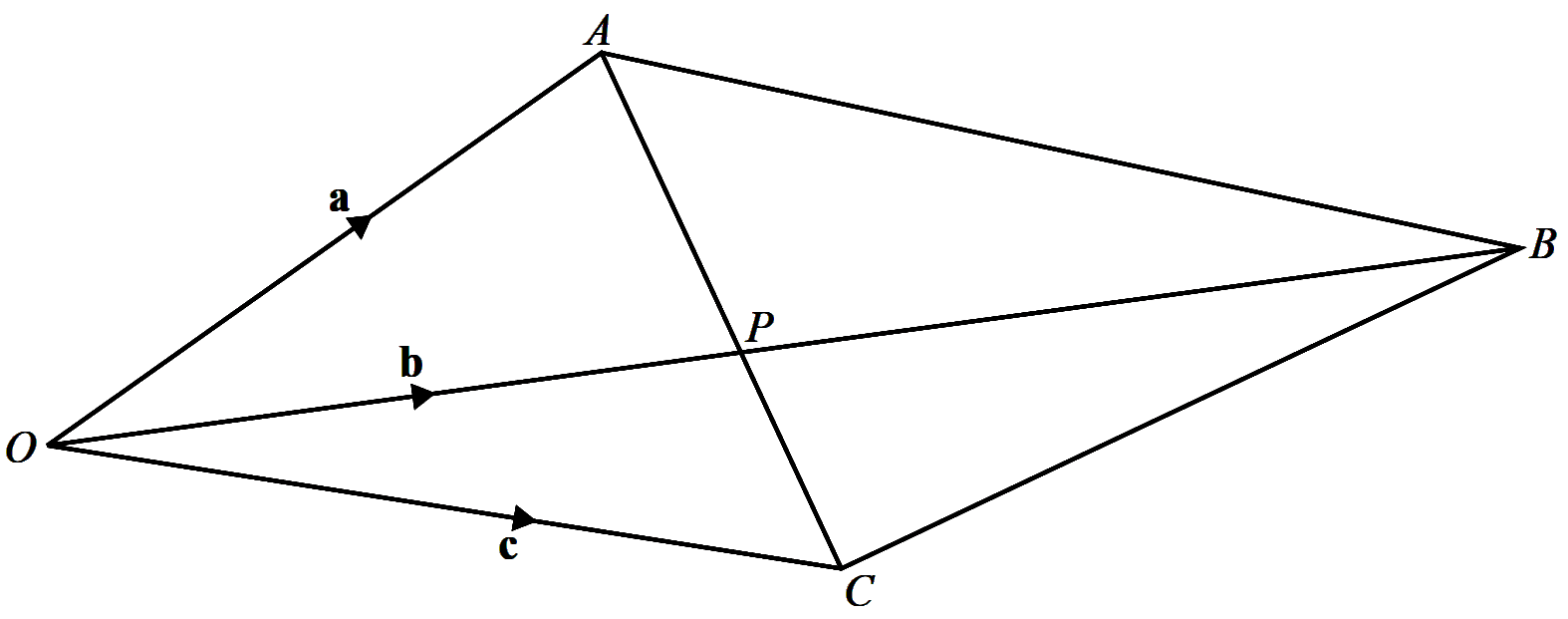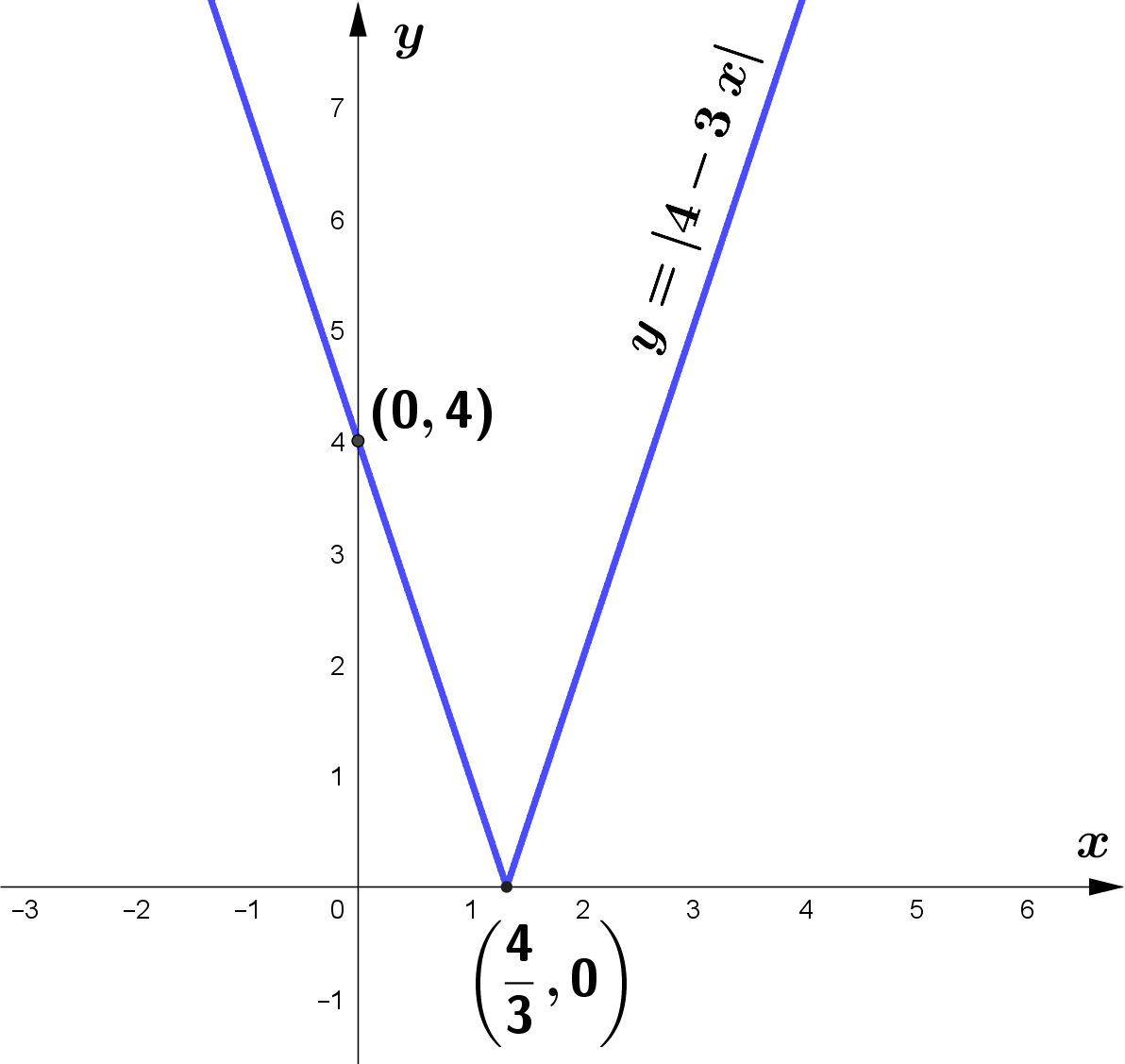-
Write $\dfrac{(p q r)^{-2} r^{\frac{1}{3}}}{\left(p^{2} r\right)^{-1} q^{3}}$ in the form $p^{a} q^{b} r^{c}$, where $a, b$ and $c$ are constants. [3]
-
(a) On the axes, sketch the graph of $y=|4-3 x|$, stating the intercepts with the coordinate axes. [2]
(b) Solve the inequality $|4-3 x|\ge 7$. [3]
-
The diagram shows the quadrilateral $O A B C$ such that $\overrightarrow{O A}=\mathbf{a}, \overrightarrow{O B}=\mathbf{b}$ and $\overrightarrow{O C}=\mathbf{c}$. The lines $O B$ and $A C$ intersect at the point $P$, such that $A P: P C=3: 2$.
(a) Find $\overrightarrow{O P}$ in terms of $\mathbf{a}$ and $\mathbf{c}$. [3]
(b) Given also that $O P: P B=2: 3$, show that $2 \mathbf{b}=3 \mathbf{c}+2 \mathbf{a}$. [2] -
A curve is such that $\dfrac{d^{2} y}{d x^{2}}=(3 x+2)^{-\frac{1}{3}}$. The curve has gradient $4$ at the point $(2,6.2)$. Find the equation of the curve. [6]
-
(a) Given that $\log _{a} p+\log _{a} 5-\log _{a} 4=\log _{a} 20$, find the value of $p$. [2]
(b) Solve the equation $3^{2 x+1}+8\left(3^{x}\right)-3=0$. [3]
(c) Solve the equation $4 \log _{y} 2+\log _{2} y=4$. [3] -
DO NOT USE A CALCULATOR IN THIS QUESTION.
A curve has equation $y=(3+\sqrt{5}) x^{2}-8 \sqrt{5} x+60$.
(a) Find the $x$-coordinate of the stationary point on the curve, giving your answer in the form $a+b \sqrt{5}$, where $a$ and $b$ are integers. [4]
(b) Hence find the $y$-coordinate of this stationary point, giving your answer in the form $c \sqrt{5}$, where $c$ is an integer. [3]
-
(a) A six-character password is to be made from the following eight characters.
$\begin{array}{llllll}\text { Digits } & \quad 1\quad & \quad 3\quad & \quad 5\quad & \quad 8\quad & \quad 9\quad \\\\ \text { Symbols } & \quad * \quad & \quad \$ \quad & \quad \# \quad & & \end{array}$
No character may be used more than once in a password. Find the number of different passwords that can be chosen if
(i) there are no restrictions, [1]
(ii) the password starts with a digit and finishes with a digit, [2]
(iii) the password starts with three symbols. [2]
(b) The number of combinations of 5 objects selected from $n$ objects is six times the number of combinations of 4 objects selected from $n-1$ objects. Find the value of $n$. [3] -
Variables $x$ and $y$ are such that $y=A x^{b}$, where $A$ and $b$ are constants. When $\lg y$ is plotted against $\lg x$, a straight line graph passing through the points $(0.61,0.57)$ and $(5.36,4.37)$ is obtained.
(a) Find the value of $A$ and of $b$. [5]
Using your values of $A$ and $b$, find
(b) the value of $y$ when $x=3$, [2]
(c) the value of $x$ when $y=3$. [2] -
(a) The first three terms of an arithmetic progression are $-4,8,20$. Find the smallest number of terms for which the sum of this arithmetic progression is greater than 2000. [4]
(b) The $7^{\text{ th}}$ and $9^{\text{ th}}$ terms of a geometric progression are $27$ and $243$ respectively. Given that the geometric progression has a positive common ratio, find
(i) this common ratio, [2]
(ii) the $30^{\text{ th}}$ term, giving your answer as a power of $3 .$ [2]
(c) Explain why the geometric progression $1, \sin \theta, \sin ^{2} \theta, \ldots$ for $-\dfrac{\pi}{2}<\theta<\dfrac{\pi}{2}$, where $\theta$ is in radians, has a sum to infinity. [2]
-
(a) Solve the equation $\sin \alpha \operatorname{cosec}^{2} \alpha+\cos \alpha \sec ^{2} \alpha=0$ for $-\pi<\alpha<\pi$, where $\alpha$ is in radians. [4]
(b) (i) Show that $\dfrac{\cos \theta}{1-\sin \theta}+\dfrac{1-\sin \theta}{\cos \theta}=2 \sec \theta$. [4]
(ii) Hence solve the equation $\dfrac{\cos 3 \phi}{1-\sin 3 \phi}+\dfrac{1-\sin 3 \phi}{\cos 3 \phi}=4$ for $0^{\circ} \leq \phi \leq 180^{\circ}$. [4] -
The normal to the curve $y=\dfrac{\ln \left(x^{2}+2\right)}{2 x-3}$ at the point where $x=2$ meets the $y$-axis at the point $P$. Find the coordinates of $P$. [7]



 $\begin{aligned}
|4-3 x| & \geq 7 \\\\
3\left|x-\frac{4}{3}\right| & \geq 7 \\\\
\left|x-\frac{4}{3}\right| & \geq \frac{7}{3} \\\\
x-\frac{4}{3} & \leq-\frac{7}{3} \text { or } x-\frac{4}{3} \geq \frac{7}{3} \\\\
x & \leq-1 \text { or } x \geq \frac{11}{3}
\end{aligned}$
$\begin{aligned}
|4-3 x| & \geq 7 \\\\
3\left|x-\frac{4}{3}\right| & \geq 7 \\\\
\left|x-\frac{4}{3}\right| & \geq \frac{7}{3} \\\\
x-\frac{4}{3} & \leq-\frac{7}{3} \text { or } x-\frac{4}{3} \geq \frac{7}{3} \\\\
x & \leq-1 \text { or } x \geq \frac{11}{3}
\end{aligned}$